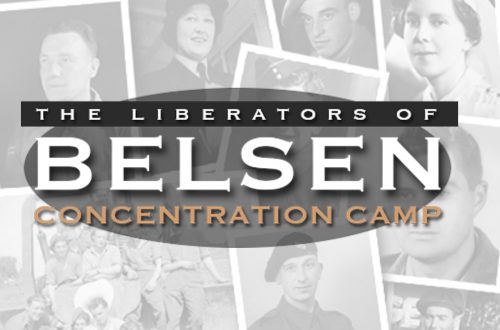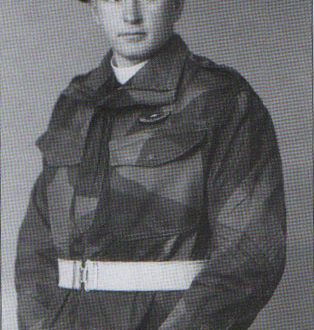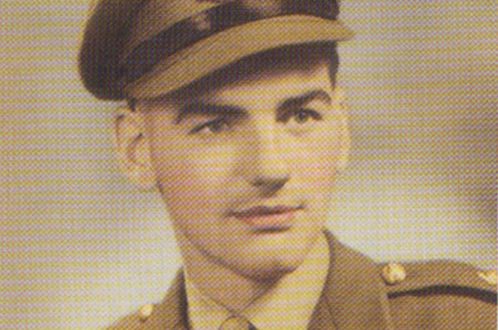
Mady Gerrard – Survivor
Today, 75 years on, SSAFA remembers the actions of the British soldiers, who did what they could to rescue and revive the thousands of people on the verge of death, from the worst terror imaginable.
The first men to enter the camp were Lieutenant John Randall, an SAS man and his driver, Cpl Brown, (Cpl John (Jock) Scott Brown (3321353) who stumbled upon it on a reconnaissance mission. At first, he believed the gates to be the entrance to a large country manor. As he entered, he passed SS Guards, and witnessed scenes of horror – and smelt the stench of death.
Mady Gerrard, was a prisoner kept at Bergen-Belsen, and saw him arrive. Knowing he was her hope of survival, she went and spoke to him. Decades later, by chance, she found him, and she became friends with her liberator.
Taken
When Hungary, Mady’s native country, was invaded by Germany in March 1944, Hitler rounded up and deported Jews to concentration camps. Mady was taken to Auschwitz on 8th July.
“Hungarian Jews were the last ones to be taken. Hitler must have known by then that the war was lost, but he was determined to get rid of any Jewish people. He had become obsessed with the Final Solution.
“I was in Auschwitz until October, when I was taken by train to a camp in a town in Germany called Guben. There were 350 girls, all the same age, taken every evening to work in a factory overnight. Before the war, it was where they made men’s hats, but we were there to make components for radios in aeroplanes with wire and plastic and things like that. Compared to Auschwitz it was paradise because they didn’t kill us, and we didn’t have to smell the stench of the burning bodies. Even the German woman responsible for us was okay, she was human.”
In the height of winter, the Russian’s advanced. The fighting was so close that Mady could hear the guns, and the German’s began to retreat. Mady was moved again, this time to Bergen-Belsen.
“Before I was moved, a woman prisoner called Molly from the same town as me, who knew me when I was four, said she recognised me because I had the same eyes as my mother. She was responsible for the camp shop and she had heard I could make things. She’d found an old knee length sock and asked if I could make her a pair of socks out of the wool, though I had nothing to make them with. My friends collected an endless supply of fir tree needles for me to knit with, as they would break. The night before we were moved on, I had to stay up and finish the socks by moonlight so Molly wouldn’t be disappointed.
“They moved us on foot, in just wooden clogs in the snow in the middle of the black forest. We walked for about 10 days, some nights they put us in stables, sometimes outside. Eventually, the guards said we would only have breaks of 15 minutes and we had to stand. My friends and I would take turns to sleep standing up and to wake two minutes before we moved again. That is how we survived.
Bergen-Belsen
“I arrived at Bergen-Belsen in January of 1944, I was almost fifteen by this time. It was the worst of everything. We realised that would be the end because there was nothing there.
“There was no sanitation, no showers. We were put into a barracks, with no furniture, lying on the floor with very little food. We didn’t know what it was, it was mostly some kind of hot liquid with some bits of cabbage or carrots in it, but sometimes there were little pieces of coal or branch of tree. We got thinner and thinner and thinner. Then we started to die by the dozens.
“I remember one day when the weather got very nice in March, we managed to sit outside in the courtyard. People from my town were there, about fifteen of them and we were all talking, and then one woman sat there just died.
“My very best friend Susie was not in the same barracks as I was, but I managed to go and see her. On the 14th April I went to her, but the spot where she would lie on the floor was empty. The ladies there said here is Susie’s blanket for you. They had to take her out last night because she died.
“My very best friend had died, not quite 24 hours earlier, and I had her blanket with me, which was riddled with lice.”
Liberation
Mady was kept in the hut nearest the gates to the camp and was one of the first people to see the British arrive.
“On the morning of the 15th we were sitting on our barracks floor, looking through the window. It was so filthy that we could hardly make out a jeep coming. We had no idea who it was, but they didn’t look like Germans. And by that stage, many of the Germans at the camp had been leaving – there were few left.
“I saw a man in uniform, he came to our door and opened it. It was full of girls like me, the same age and size – skeletons, most sat on the floor unable to stand. I later found out it was John Randall. He couldn’t believe what he saw. We spoke to him in German, saying we couldn’t speak English but we were terribly grateful.
“We knew it was liberation, and we thought it was wonderful, because we knew we only had a few days left to live. We had to be liberated at some point because the war was ending and the Germans were gone. It must’ve been the best day of my life. The conditions were impossible to imagine, to be there, I don’t wish it on anybody. Not even Adolf Hitler.
“John’s driver went back to the jeep and brought a gun, full of a powder called DDT. He sprayed it on us, and all the lice and fleas on us dropped dead on the floor. It looked like we’d had a carpet full of lice fitted the way they now covered the floor. Our bodies felt so different.
“After a few minutes he went. He obviously went to radio more of the British Forces in the neighbourhood, who hadn’t known we were there.”
Relief Effort
Later that day more British troops arrived and began the relief effort to help as many people as possible. The effort helped save many lives, but for many it was not enough. The military were unprepared for the extreme conditions they found the people in, and the scale of the trauma.
“I can only praise them. We knew they were British. And we knew that we were free, sort of. We were free, but we couldn’t walk very well.
“They set up temporary bakeries, they could only give what they had to feed themselves. They didn’t know they were going to meet emaciated people, thousands.
“They had cold tins of baked beans with smoked sausages or smoked bacon and we ate this with hot bread. We were obviously so starved, that we devoured the food they gave us, and quite a number of people died as a result. Their stomachs couldn’t take it.
“The Germans who were living in an ordinary town nearby, where the Hitler youth trained pretended that they didn’t know anything about it, so when the Brits took over, they brought small cars of German people from the neighbourhood to see the place. They maintained that they had absolutely no idea that the camp existed, but how would that be possible? The smell, the stench! They would’ve smelt it. They pretended to be very sorry.
Mady was transferred into the town of Belsen where she was given food, and a doctor would visit every two or three days (due to the number of patients they had to see). Mady had contracted Typhus, a deadly disease and was sent to a temporary hospital.
“I was very lucky because I became ill and the doctor was coming on the same day.
“By this time the Brits had handed us over to the Americans to look after, and without asking questions they gave everyone a pack of cigarettes. It didn’t matter if you were dying of lung cancer or tuberculous or anything, you got a pack of cigarettes! I had never smoked a day in my life, but I kept the pack, as I thought I could use them as a currency.
“In hospital with Typhus and now jaundice, they kept me on a strict diet, and I was starving. But I was told if I ate, I would die. The hospital was full of international staff and I managed to bribe a young Polish man giving out the food, to give me a bowl of sauerkraut in exchange for the cigarettes.
I ate a part of this dreadful fat Sauerkraut and by the next morning I didn’t have jaundice and I didn’t have typhus either.”
Recuperation
While Mady was in hospital the Swedish Red Cross arrived at Belsen and offered to take 350 survivors to Sweden to recuperate. Mady was chosen to go.
“They had to be sure I would survive the journey and I had to sign all sorts to say if I died that it wasn’t their fault. I was fifteen in the third week in May, and they took me to Sweden by boat, like ambulances in the water, to a marvellous temporary hospital in a school. They had towels, and hot showers, and sheets, and food. And they decided, because I was quite ill, weighing just 24KG (under 4 stone), that they’d have to pump me up, because if I couldn’t put on enough weight in a short enough time, I would not survive. I went from 24kg to 56kg and I was fat!”
“In September, when children had to return back to school, we were asked if we wanted to stay in the Stockholm area, and if so, we needed to find jobs. So, I became an Au Pair there. I think I may have been the first Au Pair in the world!
“I went to a family – a Swedish man, American wife, American Mother in law and three children. I didn’t know any English, but both parents spoke German and I learned Swedish. I was happy with them.
“I spent a lot of time with the lady of the house. She told me that during a really bad part of the war– they had to use cream instead of milk, and margarine instead of butter – she expected me to understand that that was difficult!”
Moving Forward
After her time in Sweden, Mady moved back to Hungary, which she recounts as a terrible mistake.
“I was sixteen by this time and I was terribly lonely. I was still hoping my father survived, and my boyfriend. I had a boyfriend from age 12 and there was no doubt in anybody’s mind we would get married eventually – he was going to be a doctor, and I was going to be an art historian. He was seventeen on the day the Germans invaded Hungary, 19th March 1944. He didn’t survive. My father who was 41 also didn’t survive.
“I couldn’t settle – I hated it. I came from a very wealthy family – and my mother’s brother gave me a room in his house, but the day after I arrived, he told me I had to go to the labour exchange to look for a job, so I couldn’t go back to school. I went to evening classes and that’s where my further education came from.
“Eventually I got married and had a little girl, and then I got divorced.
“In 1956 when the revolution in Hungary broke out, I organised to leave the country with my daughter. Illegally we went to Cardiff.”
After five years Mady became a British citizen, all the while developing a fashion brand of crocheted and painted silk garments. She became famous, moving to New York for a time, mixing with presidents and celebrities, before returning to be with her daughter and grandchild.
“The second he was born I just wanted to come back, to go home. I’ve now lived here for sixty-three years, and I still think it’s the most decent country in the world.”
Mady now has three grandchildren, and two great-grandchildren
Reuniting
On 10th April 2005, Mady saw an article in The Sunday Telegraph, and screamed.
“In the middle of the paper was almost a full-page article about a distinguished man in uniform with an SAS beret on. The title of article was ‘the gates of hell’, and it was about John Randall just before the 60th Anniversary of the liberation. It was the exact same story, my story.
“I knew he was the man and I screamed so loud my dog thought I had gone mad. I always thought I would remember him if I saw him in the street, but how would that be possible? He would have aged like I have. But I saw the picture of him from those years before and knew he was the man who gave me back my life.
“I was dying to see him, so I called The Telegraph and through them I wrote to him. I said how unbelievably grateful I was, and that I was dying to see him, delighted that he is alive and well, and I wish him all the very best.
“The next Monday, I got a call. The phone rang, and he said, is that Mady? I couldn’t believe it! 60 years since we’d spoken to each other for around three minutes in two languages!
“We arranged to meet in London, and to anyone looking from the outside, you’d had thought we’d been friends for years. He told me he had been very lucky; he had been married for 56 years to a wonderful woman and had three children. I told him about my life and we spoke about Bergen-Belsen. He said it was the worst day of his life.
“We became very good friends for 11 years until he died, visiting as often as we could. He was a remarkable man. He wrote a foreword for my book and I encouraged him to write his own ‘The Last Gentleman of the SAS’.
“He was a friend, but he was also my hero. I was lucky it was him and not anyone else who walked through the gates, and the fact I found him all those years later makes the story even more remarkable.
“If he hadn’t of come in, more of us would’ve died. I think about him. I miss him terribly.”
John Randall died in 2016 and was cremated in a non-religious ceremony. Mady believes his experience at Bergen-Belsen caused him to reject religion.
“I don’t like funerals, but the ceremony was perfect, and John’s eldest son Nigel wrote a beautiful send off for his father. He promised to keep his father’s wish, and that the most important thing was to be kind look after each other.”
Now
Now Mady uses her experience to teach others. She dedicated a speech at the Welsh Assembly to John, and she works with different faith schools, from all religions, to teach children there about the history of the Holocaust, and to encourage them to learn lessons from the past.
She recounts one poignant moment at a school where a young boy asked, ‘did you lose your faith when you came out of the camp?’.
“Such an amazing question from a little boy – I had to think. I had to tell him yes because how could I say no?”
Ref: SSAFA.org.uk
9,850 total views




